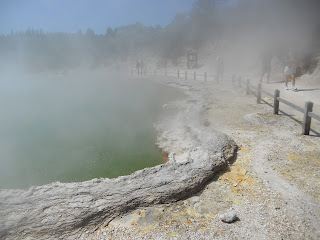Lady Knox Geyser
We were in time for 10.15a.m. when the geyser erupts daily.( Obviously this is not a natural occurence at the same time daily.) A guide poured a packet of soapflakes into the vent. The soap reduces the water's surface tension, and superheated steam and water were released in a jet reaching about 10 metres.
Mud pools
We then drove round the corner to an active boiling mud pool which plopped away merrily forming lovely concentric circles. Click to see video...
Thermal Park
We then drove back the short way to the main site for the hour-long walking loop past a number of lakes formed from volcanic craters. The craters are up to 50 metres in diameter and up to 20 metres deep. Most of these craters have been formed in the past few hundred years by the action of acidic steam rising from super-heated under-ground water dissolving the ground above and ultimately causing it to collapse.
Devils Home.
An example of a collapsed crater due to underground acid on the rock. The rough sides and yellow/greenish colours are where volcanic vapours have coloured the walls
Rainbow Crater
Named after the sulphur crystals and coloured mineral viens. There is a steaming area where crystals form.
Thunder Crater
Formed in 1968, with steaming water at the bottom illustrating the cause of the erosion.

Devil's Ink Pots
A series of mud pools whose water levels fluctuate with the amount of rainfall. The colour is due to small amounts of graphite and crude oil brought to the surface by the water forcing its way up.The Artist's Palette
Overflowing water from the Champagne Pool* draws with it minerals that have originated from below the surface. As the waters cool and the minerals are exposed to our atmosphere they show themselves in a variety of locations and colours depending on water levels and wind direction.
*The Champagne Pool was formed 700 years ago and has a surface temperature of 74 degrees C.
Now we know what a 'hot seat' really means!
We had arranged to meet up at Rotorua with Richard Millard (ex-BT colleague of Steve's) and his mother, Margaret, who coincidentally are in New Zealand visiting his brother. It was a real bonus for us being with Richard as he is very knowledgable about geology.
Opal Pool
This is a sulphurous spring named after its greenish yellow colour.
Wai-O-Tapu is the only thermal park in New Zealand where you can walk across a crater on a boardwalk. The boardwalk across Opal Pool rests on specially treated timber secured by stainless steel pins. Which is good to know when you are walking along it!!
Sulphur Cave
Sulphur crystals have formed beautiful formations on the cave wall above the vents. There are also some of the few chlorine pools in the area that may have been suitable for cooking in.
The Devil's Bath
A large raggedly-edged crater with an amazing natural water colour at its base. The colour changes from green to yellow depending on the amount of reflected light and cloud cover.




































1 comment:
Boy some of these photos take me back to our vacation in 2008 and the hot springs at Rotorua - you sure do look like you are having a FABULOUS time
Kathyk
Post a Comment